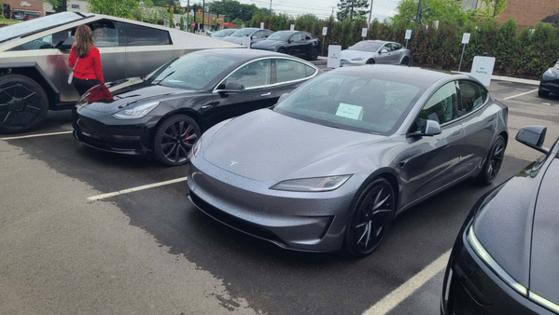Auto review: Second-gen Tesla Model 3 Performance takes big leap forward (and a step back)
Published in Automotive News
CHARLEVOIX, Michigan — After not touching the steering wheel on Full Self-Driving for an hour and a half up I-75, I exited the freeway at Gaylord. Turning on to the M-32 twisties, I took back the controls — my left thumb searching for the turn signal — from Autopilot. ZOT! The sedan rocketed past 60 mph in less than three seconds, its colossal 554 pound-feet of torque burying my spine in the seatback.
The second-generation Tesla Model 3 Performance is here, and it’s two steps forward — and one step back.
Or maybe I should say leaps instead of steps. As the most innovative brand of the 21st century commandeered by the most mercurial CEO since Henry Ford (imagine the blowback to Ford’s building WW2 bombers for FDR in today’s political climate), Tesla hasn’t been shy about trying to reinvent the automobile, whether design, autonomous driving, or electric power. I’ve owned both generations of the Model 3 Performance and they have been a nonstop, exhilarating, nerve-wracking journey on the cutting edge of auto tech.
Happily, the journey is now shorter to pick up a new car.
Leap forward. Six years ago, I picked up my 2019 M3P at Tesla’s Shaker Heights showroom outside Cleveland ... because Michigan, um, banned Tesla showrooms. Today, thanks to a Whitmer administration initiative, Tesla has four showroom/service centers in Michigan — including in my West Bloomfield backyard. The no-haggle, online purchase process is easy-as-pie.
Leap forward. I was excited for the new 2025 Performance model for no other reason than designer Franz von Holzhausen has cleaned up the design. With its wide hips and coupe-back roof, M3 was always a looker from behind — but, oh, that face!
Determined to be different (Tesla’s North Star), the American startup’s first mass-produced car (it has sold a remarkable 2 million units since its 2017 introduction) scrubbed its front end of any trace of a grille. The result was a featureless face that reminded me of the Harry Potter villain, Voldemort. Eek.
Gen 2 is a dramatic improvement. The nose is sharper, more sculpted — its lean theme extending rearward with thinner headlights/taillights and more toned stampings. Always distinctive, Model 3 is now the peer of its handsome European competition.
Leap backward. Over those six years, I put just 14,331 miles on the odometer as an auto critic testing over 60 cars a year. No matter. The residuals of Model 3 Production models are through the floor (an EV affliction).
My low-mileage 2019 M3P cost $63,940 in 2019 and was listing no better than $22,000 on the used market — a 65% depreciation. A comparable, gas-fueled 2019 BMW M2 Competition, by comparison, held its value at $51,000 — just a 15% depreciation.
I took Tesla’s $19,500 trade-in on a new, 2025 M3P priced for $62,000.
Unlike 2019, that price did not come with a $7,500 federal tax credit, the ceiling having been lowered to $60,000 for EVs to qualify ($80,000 for EV SUVs like a Tesla Model X). On the other hand, I was able to transfer my Full Self-Driving capability (an $8,000 value, up from $5,000 in 2019) from my old Tesla to the new bot.
Leap forward. And what a bot it is.
The advances in self-driving since 2019 are remarkable. When I drove my 2019 MP3 home from Cleveland, the system only worked on divided highways, and I had to keep my hand on the wheel.
When I picked up my 2025 Model 3 Performance from West Bloomfield, I gave it my address and it drove itself home. Credit Tesla’s relentless race with Google and Amazon for the Holy Grail of self-driving. Google is trying to achieve full, Level 4 driverless autonomy using Lidar, while Tesla is convinced it can get the job done with cheaper cameras.
Production cars like my M3P, however, are still Level 2, meaning that, on my trip to Charlevoix, the car constantly monitored my eyes for engagement.
While hands-free systems from General Motors Co. and Ford Motor Co.are mostly limited to divided highways, Tesla will drive to your destination as long as the road has painted lines. With a full 296 miles of range, I instructed the Tesla to navigate back from Charlevoix to my home, a 250-mile trip. Included was a 10-minute charging stop at Meijer’s Bay City store.
Not only did the Tesla navigate to the charger, but — upon arrival — it parked itself at one of the charging stalls. Press the turn signal, and M3P backed into the first available space.
Leap backward. That’s right, I “pressed” the turn signal.
In its quest to simplify cabin controls (and, no doubt, manufacturing), Tesla messed up one of the coolest cabin operations in autodom. The OG steering wheel was an aesthetically clean creation with two scroll wheels handling functions from mirrors to steering-wheel position to cruise control-speed to volume. Shifting/FSD and turn signals? Handled by two column stalks.
For 2025, Tesla has removed the stalks, leading to a mess o’ complications. Shifting is now done in the 15.4-inch center infotainment screen — an echo of other brand methods (think Lincoln’s console shifter buttons or GMC’s piano keys). Operation briefly takes your eyes off the road.
But moving turn signal and FSD commands to the steering wheel requires a blizzard of icons (for voice, cruise control, arrows for turn signals).
The latter is the most problematic, as you now have to feel for the turn signal buttons next to a braille locator. Argh. As I turned the wheel onto M-32 in Gaylord, I fished for the turn signal buttons at the same time — clumsy when compared to the simple pull of a stalk.
“It’s not just dumb, it’s unsafe,” bemoans YouTube colleague Jason Camissa. Aftermarket companies have already crafted stalk solutions. Stalks aside, passengers will appreciate conveniences like ambient lighting, better-fitting seats and a rear-seat screen with climate control.
Leap forward. Of course, you don’t need stalks when you release the Kraken on M-32's curves.
Here, the new M3P shines. The Tesla is noticeably better screwed together than the last gen. Solid chassis, quiet cabin, while unlocking an impressive 83 more torque (and 37 more horsepower). Remarkably, Tesla has achieved this while actually REDUCING curb weight from 4,072 pounds to 4,054. Has any modern performance car gotten lighter from one gen to the next? Ever?
That light weight contributes to nimble center entry and face-flattening thrust on exit. Alas, turn-in is still numb, but magnetic shocks have made for a more compliant suspension.
Tesla’s charging and self-driving supremacy hint at an autonomous future. But the Gen 2 M3P’s aesthetics and handling are welcome indications that Tesla hasn’t forgotten what makes performance sedans fun to drive.
2025 Tesla Model 3 Performance
Vehicle type: All-wheel-drive, five-passenger sedan
Price: Base $56,380, including $1,390 destination charge ($64,630 as tested)
Powerplant: Lithium-ion battery pack mated to dual electric motors
Power: 510 horsepower, 554 pound-feet torque
Transmission: Single-speed automatic
Performance: 0-60 mph, 2.8 seconds (Car and Driver); top speed, 155 mph
Weight: 4.054 pounds
Range: 298 miles on full charge
Report card
Highs: Improved build; improved design
Lows: Poor residuals; where’d the stalks go?
Overall: 4 stars
____
©2025 www.detroitnews.com. Visit at detroitnews.com. Distributed by Tribune Content Agency, LLC.








Comments